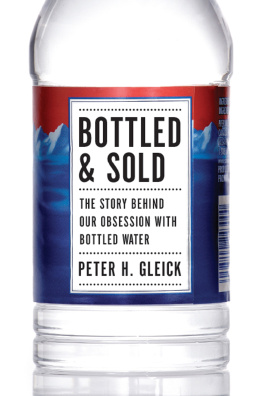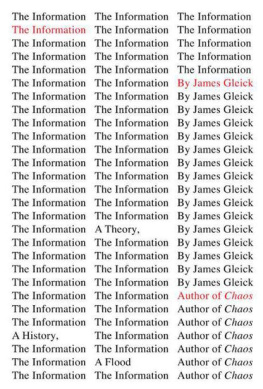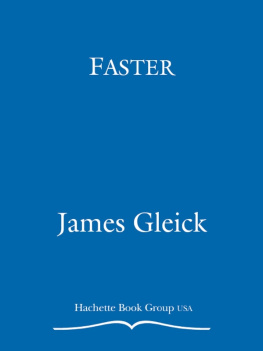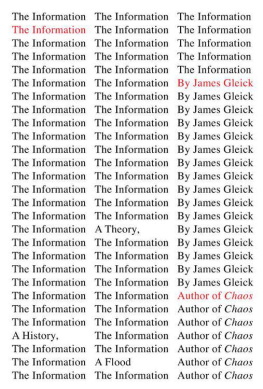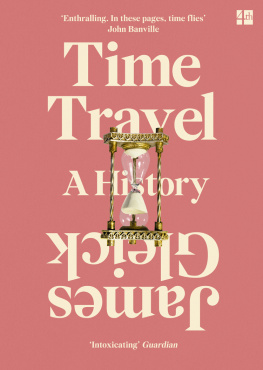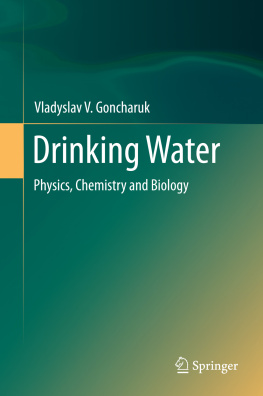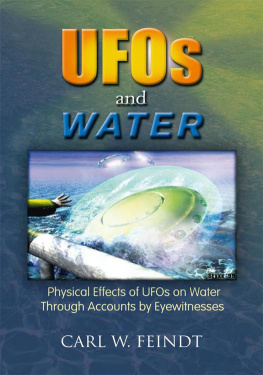Peter H. Gleick
Copyright 2010 Peter H. Gleick
All rights reserved under International and Pan-American Copyright Conventions. No part of this book may be reproduced in any form or by any means without permission in writing from the publisher: Island Press, Suite 300, 1718 Connecticut Ave., NW, Washington, DC 20009.
ISLAND PRESS is a trademark of the Center for Resource Economics.
p. cm.
Includes bibliographical references and index.
ISBN-13: 978-1-59726-528-7 (cloth : alk. paper)
ISBN-10: 1-59726-528-4 (cloth : alk. paper)
ISBN-13: 978-1-59726-810-3 (electronic)
1. Bottled water. I. Title.
TP659.G54 2010
663'.61dc22
Design by Joyce C. Weston
Manufactured in the United States of America
10 9 8 7 6 5 4 3 2 1
PREFACE
A Thousand Bottles a Second
T HINK ABOUT WHERE you are right now. How far away is the nearest faucet with safe water? Probably not very far. Yet every second of every day in the United States, a thousand people buy and open up a plastic bottle of commercially produced water, and every second of every day in the United States, a thousand plastic bottles are thrown away. Eighty-five million bottles a day. More than thirty billion bottles a year at a cost to consumers of tens of billions of dollars. And for every bottle consumed in the U.S., another four are consumed around the world.
Why do we buy bottled water? Where does it come from? Whats really in the bottles we buy? Is it as safe as tap water, or even safer, as we are often told? What about the plastic? Where do those bottles go when we throw them out? What are the environmental and social consequences of bottled water use for the planet? The beverage industry tells us that bottled water is just a simple commodity like any other food producta safe, well-regulated alternative to tap water. The environmental community tells us bottled water is a corporate plot to privatize a precious public resource and that its even less safe than our tap water. What is the truth?
I decided to write this book in part to gain a better understanding of what the explosive growth of the bottled water industry really means for us and for the future of drinking water. In the course of writing it, Ive interviewed people who have made a business out of bottling and selling water, met with passionate environmental activists vociferously opposed to bottled water, visited the factories where petroleum and raw water are turned into neat little containers of commercial product, and looked out over acres of plastic waste and the landfills where that waste will end up lying intact for centuries. I believe that bottled water is a symptom of a larger set of issues: the long-term decay of our public water systems, inequitable access to safe water around the world, our susceptibility to advertising and marketing, and a society trained from birth to buy, consume, and throw away. I believe that bottled water can only be understood within the broader context of these phenomena.
The globe is in the midst of a major transition to what I call the Third Water Agea transition to a truly sustainable system of managing and using our most precious resource. The First Age began when humans emerged as thinking beings and depended on the vagaries of the natural hydrologic cycle to take what water was needed and to get rid of wastes. The transition to the Second Water Age began when humanity started to outgrow the limits of local water resources and to intentionally manipulate the hydrologic cycle, building the earliest dams, aqueducts, irrigation canals, and wastewater systems, and putting in place the first laws and social structures for managing water. The Second Water Age reached full flower in the nineteenth and twentieth centuries when societies began to master the complex chemical, engineering, biological, and institutional tools that characterize our modern water systems. The Second Age brought us enormous benefits but has ultimately proven inadequate to the growing need. Billions of people still lack safe water and sanitation. Aquatic ecosystems continue to be devastated by our use, diversion, and contamination of fresh water. Conflicts over shared water resources are growing. Climate changes are already altering the planets fundamental hydrological conditions.
The growing use of bottled water is further evidence that the old ways of managing our limited water resources are on the wrong side of history and that a new way of thinking is needed. We are now, I believe, in the midst of another transition, to a Third Water Age. My fear is that this Third Age could consist of the complete abandonment of our efforts to provide safe public tap water for all in favor of privately produced and sold bottled water. My hope is that the Third Age will instead follow a soft path for watera comprehensive approach to sustainable water management and use, requiring equitable access to water, proper application and use of economics, comprehensive protection of aquatic ecosystems, incentives for efficient water use, new sources of supply, smart use of innovative technology, improved water quality and delivery reliability, strong public participation in decision-making, and more. In my vision of Third Age, access to affordable safe tap water would be universal and bottled water use would become unnecessary. Government regulatory agencies would successfully protect the public from water contamination, false advertising, misleading marketing, and blatant hucksterism. Public access to drinking water would be easy, and selling bottled water would be difficult. And while bottled water will always be an option for those that want it, in this positive vision of the future bottled water companies would have to incorporate the true economic and environmental costs of the production and disposal of plastic bottles, as well as the extraction and use of sensitive groundwater, into the price of their product, further drying up bottled water sales. But this future vision is not todays reality: none of these things are true now, and so we buy bottled water. Lots of it.
The story of bottled water is a story with big numbers: billions of gallons or liters sold; billions of bottles produced, used, and thrown away; tens or hundreds of billions of dollars in sales; billions of tons of carbon dioxide and other pollutants produced. But it is also a story about a billion people worldwide without access to safe and affordable drinking water, and billions of illnesses and millions of deaths every yearmostly among small childrenfrom preventable water-related diseases.
People usually say they buy bottled water for four major reasons: fear of their tap water, convenience, taste, and style. The news is filled with stories about water contamination and so we start to fear that our tap water is polluted by things we cannot see or smell. We seek the convenience of little portable packages of water that are available wherever and whenever we want them because we can no longer find a clean, working water fountain. Sometimes we really dont like how our tap water tastes. And were misled by intensive advertising into believing that this or that brand of commercial water will make us healthier, skinnier, or more popular.

